Maintaining Safe Practices During Phlebotomy for Technicians
VerifiedAdded on 2023/01/03
|35
|12212
|1
Dissertation
AI Summary
This dissertation investigates the critical role of safe practices in phlebotomy, focusing on the potential risks to both lab technicians and patients, such as nerve damage, allergic reactions, and hematoma formation. The study explores effective strategies for minimizing these risks and enhancing clinical outcomes, including awareness raising, the use of safety-engineered devices, and proper needle disposal. It also emphasizes the importance of hand hygiene and the use of well-fitting gloves. The research aims to analyze how safe practices can be integrated and maintained within phlebotomy procedures to reduce errors and improve patient safety. The study also provides insights on the research question of how safe practices can be maintained amongst lab technicians during phlebotomy to reduce errors in health outcomes. The research objectives include exploring potential risks, determining the effectiveness of safe practices, and analyzing ways to integrate and maintain safe practices within the phlebotomy procedure. The study's methodology involves inclusion and exclusion criteria, ethical considerations, and data extraction to provide detailed knowledge and information on the topic.
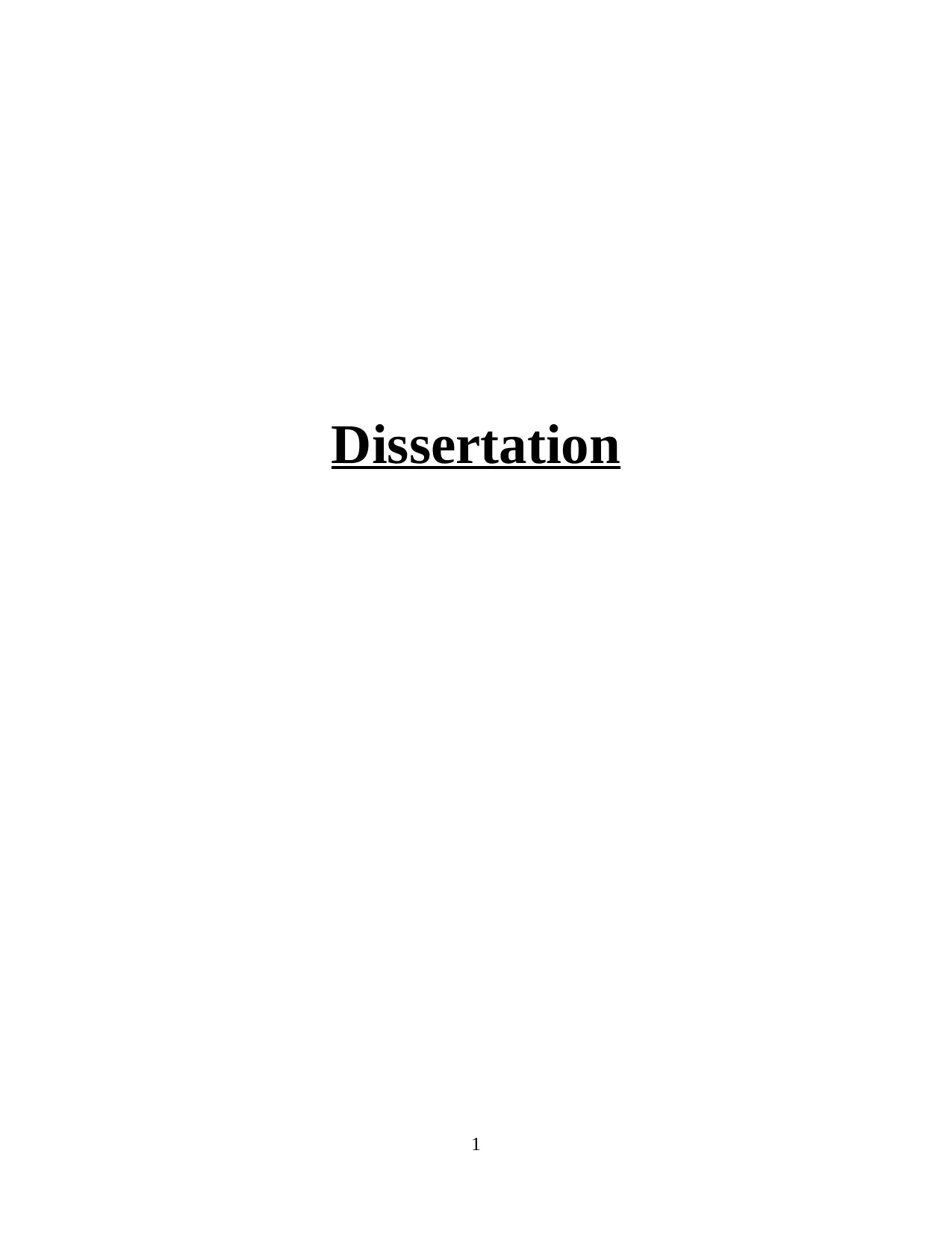
Dissertation
1
1
Paraphrase This Document
Need a fresh take? Get an instant paraphrase of this document with our AI Paraphraser
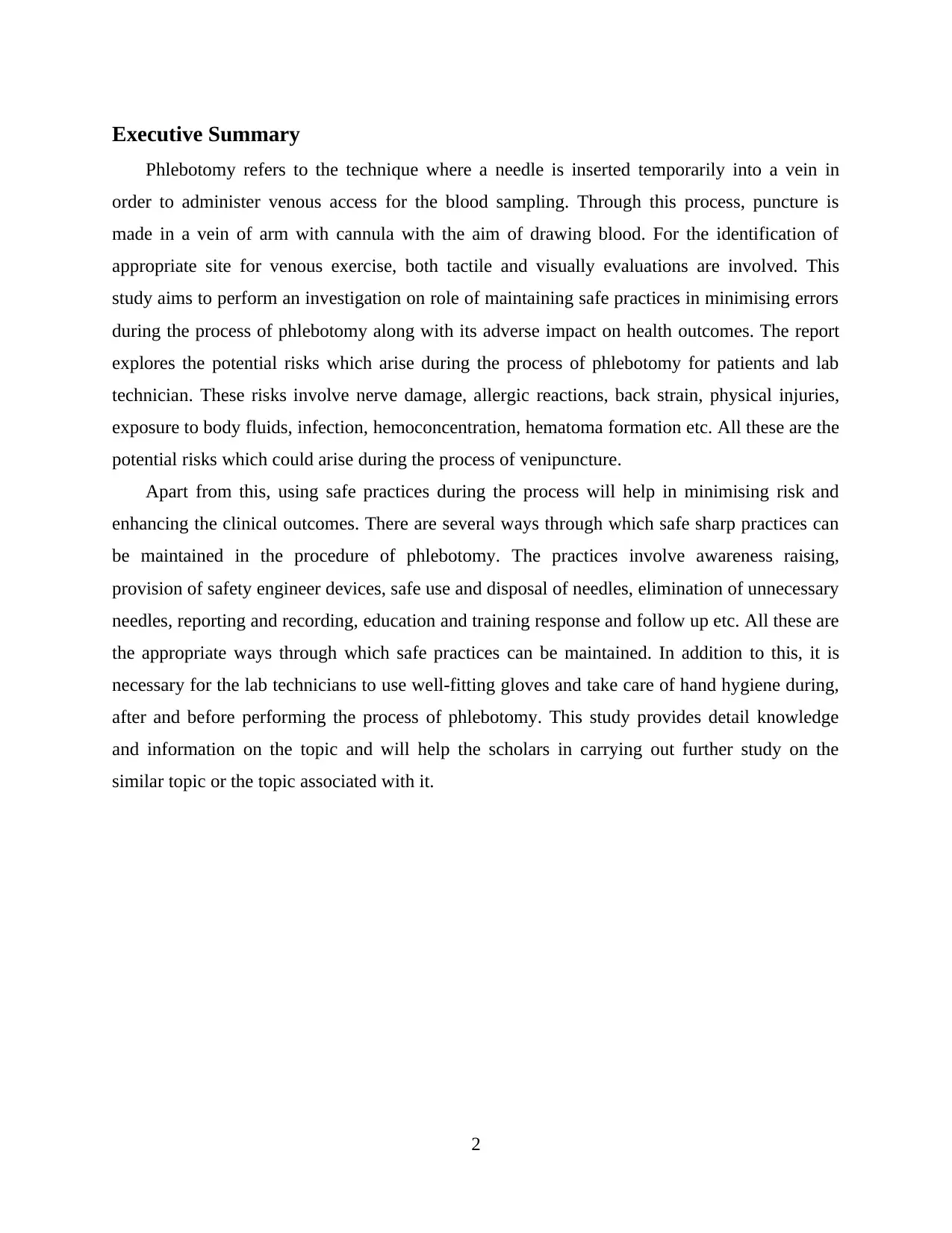
Executive Summary
Phlebotomy refers to the technique where a needle is inserted temporarily into a vein in
order to administer venous access for the blood sampling. Through this process, puncture is
made in a vein of arm with cannula with the aim of drawing blood. For the identification of
appropriate site for venous exercise, both tactile and visually evaluations are involved. This
study aims to perform an investigation on role of maintaining safe practices in minimising errors
during the process of phlebotomy along with its adverse impact on health outcomes. The report
explores the potential risks which arise during the process of phlebotomy for patients and lab
technician. These risks involve nerve damage, allergic reactions, back strain, physical injuries,
exposure to body fluids, infection, hemoconcentration, hematoma formation etc. All these are the
potential risks which could arise during the process of venipuncture.
Apart from this, using safe practices during the process will help in minimising risk and
enhancing the clinical outcomes. There are several ways through which safe sharp practices can
be maintained in the procedure of phlebotomy. The practices involve awareness raising,
provision of safety engineer devices, safe use and disposal of needles, elimination of unnecessary
needles, reporting and recording, education and training response and follow up etc. All these are
the appropriate ways through which safe practices can be maintained. In addition to this, it is
necessary for the lab technicians to use well-fitting gloves and take care of hand hygiene during,
after and before performing the process of phlebotomy. This study provides detail knowledge
and information on the topic and will help the scholars in carrying out further study on the
similar topic or the topic associated with it.
2
Phlebotomy refers to the technique where a needle is inserted temporarily into a vein in
order to administer venous access for the blood sampling. Through this process, puncture is
made in a vein of arm with cannula with the aim of drawing blood. For the identification of
appropriate site for venous exercise, both tactile and visually evaluations are involved. This
study aims to perform an investigation on role of maintaining safe practices in minimising errors
during the process of phlebotomy along with its adverse impact on health outcomes. The report
explores the potential risks which arise during the process of phlebotomy for patients and lab
technician. These risks involve nerve damage, allergic reactions, back strain, physical injuries,
exposure to body fluids, infection, hemoconcentration, hematoma formation etc. All these are the
potential risks which could arise during the process of venipuncture.
Apart from this, using safe practices during the process will help in minimising risk and
enhancing the clinical outcomes. There are several ways through which safe sharp practices can
be maintained in the procedure of phlebotomy. The practices involve awareness raising,
provision of safety engineer devices, safe use and disposal of needles, elimination of unnecessary
needles, reporting and recording, education and training response and follow up etc. All these are
the appropriate ways through which safe practices can be maintained. In addition to this, it is
necessary for the lab technicians to use well-fitting gloves and take care of hand hygiene during,
after and before performing the process of phlebotomy. This study provides detail knowledge
and information on the topic and will help the scholars in carrying out further study on the
similar topic or the topic associated with it.
2
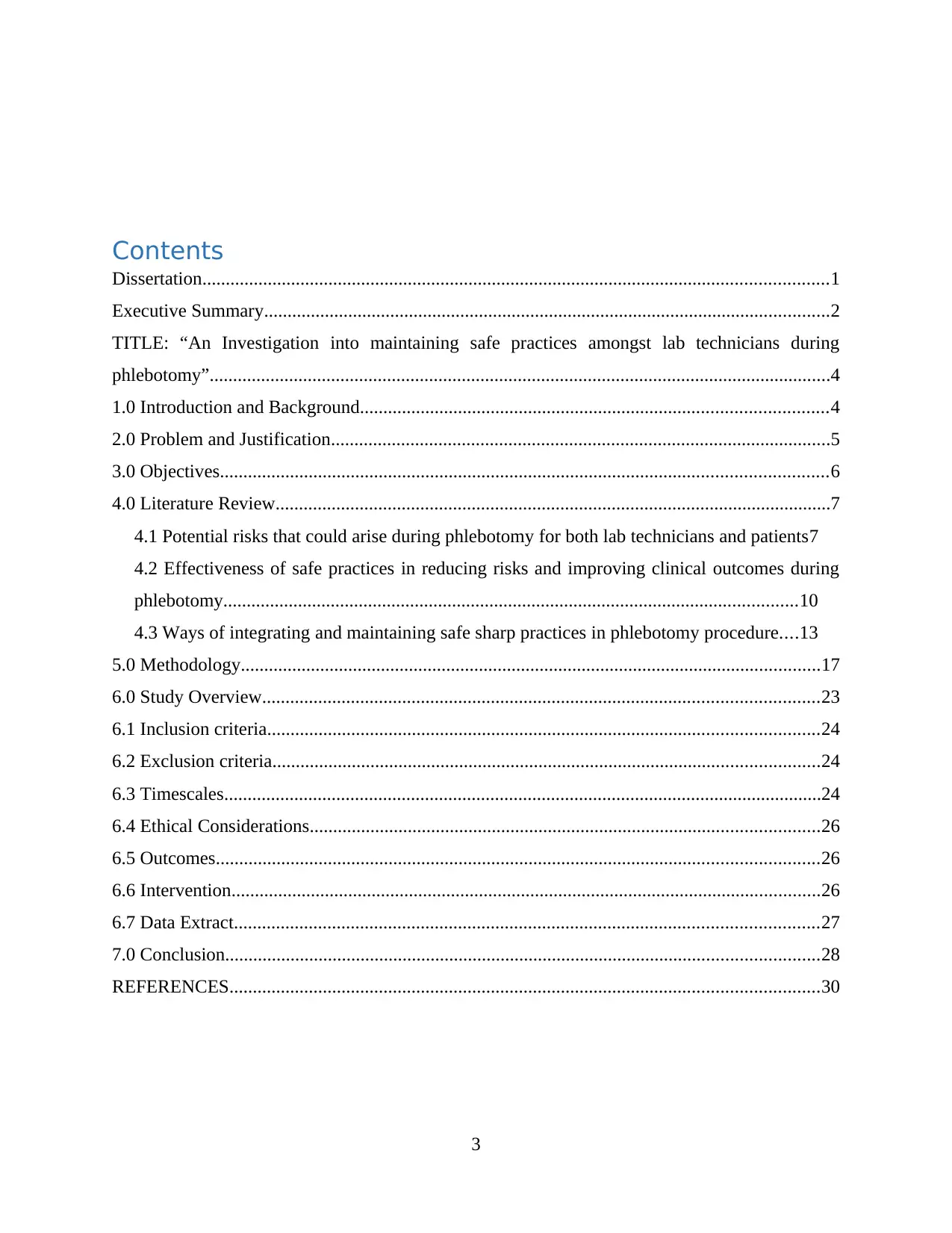
Contents
Dissertation......................................................................................................................................1
Executive Summary.........................................................................................................................2
TITLE: “An Investigation into maintaining safe practices amongst lab technicians during
phlebotomy”.....................................................................................................................................4
1.0 Introduction and Background....................................................................................................4
2.0 Problem and Justification...........................................................................................................5
3.0 Objectives..................................................................................................................................6
4.0 Literature Review.......................................................................................................................7
4.1 Potential risks that could arise during phlebotomy for both lab technicians and patients7
4.2 Effectiveness of safe practices in reducing risks and improving clinical outcomes during
phlebotomy...........................................................................................................................10
4.3 Ways of integrating and maintaining safe sharp practices in phlebotomy procedure....13
5.0 Methodology............................................................................................................................17
6.0 Study Overview.......................................................................................................................23
6.1 Inclusion criteria......................................................................................................................24
6.2 Exclusion criteria.....................................................................................................................24
6.3 Timescales................................................................................................................................24
6.4 Ethical Considerations.............................................................................................................26
6.5 Outcomes.................................................................................................................................26
6.6 Intervention..............................................................................................................................26
6.7 Data Extract.............................................................................................................................27
7.0 Conclusion...............................................................................................................................28
REFERENCES..............................................................................................................................30
3
Dissertation......................................................................................................................................1
Executive Summary.........................................................................................................................2
TITLE: “An Investigation into maintaining safe practices amongst lab technicians during
phlebotomy”.....................................................................................................................................4
1.0 Introduction and Background....................................................................................................4
2.0 Problem and Justification...........................................................................................................5
3.0 Objectives..................................................................................................................................6
4.0 Literature Review.......................................................................................................................7
4.1 Potential risks that could arise during phlebotomy for both lab technicians and patients7
4.2 Effectiveness of safe practices in reducing risks and improving clinical outcomes during
phlebotomy...........................................................................................................................10
4.3 Ways of integrating and maintaining safe sharp practices in phlebotomy procedure....13
5.0 Methodology............................................................................................................................17
6.0 Study Overview.......................................................................................................................23
6.1 Inclusion criteria......................................................................................................................24
6.2 Exclusion criteria.....................................................................................................................24
6.3 Timescales................................................................................................................................24
6.4 Ethical Considerations.............................................................................................................26
6.5 Outcomes.................................................................................................................................26
6.6 Intervention..............................................................................................................................26
6.7 Data Extract.............................................................................................................................27
7.0 Conclusion...............................................................................................................................28
REFERENCES..............................................................................................................................30
3
⊘ This is a preview!⊘
Do you want full access?
Subscribe today to unlock all pages.

Trusted by 1+ million students worldwide

4
Paraphrase This Document
Need a fresh take? Get an instant paraphrase of this document with our AI Paraphraser
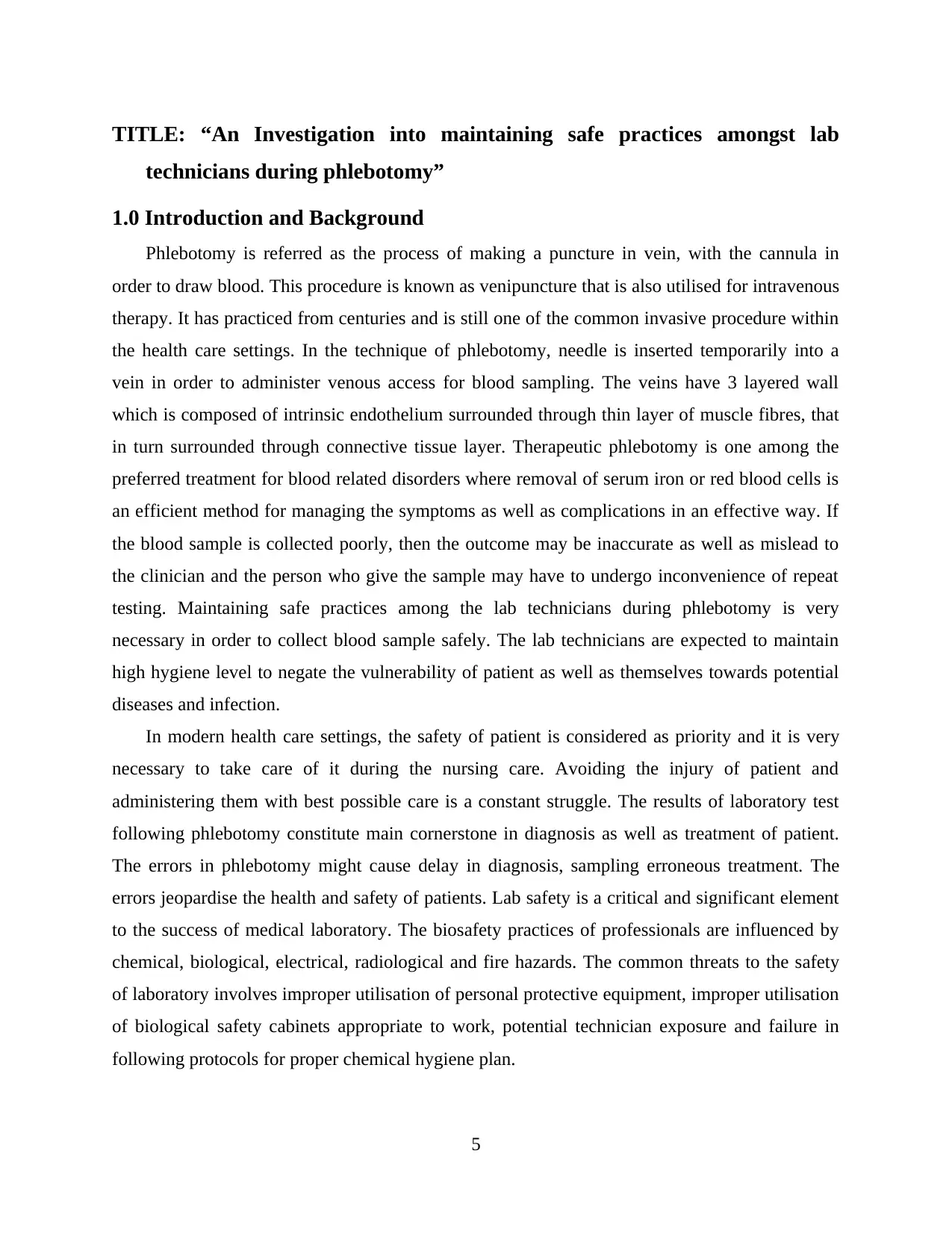
TITLE: “An Investigation into maintaining safe practices amongst lab
technicians during phlebotomy”
1.0 Introduction and Background
Phlebotomy is referred as the process of making a puncture in vein, with the cannula in
order to draw blood. This procedure is known as venipuncture that is also utilised for intravenous
therapy. It has practiced from centuries and is still one of the common invasive procedure within
the health care settings. In the technique of phlebotomy, needle is inserted temporarily into a
vein in order to administer venous access for blood sampling. The veins have 3 layered wall
which is composed of intrinsic endothelium surrounded through thin layer of muscle fibres, that
in turn surrounded through connective tissue layer. Therapeutic phlebotomy is one among the
preferred treatment for blood related disorders where removal of serum iron or red blood cells is
an efficient method for managing the symptoms as well as complications in an effective way. If
the blood sample is collected poorly, then the outcome may be inaccurate as well as mislead to
the clinician and the person who give the sample may have to undergo inconvenience of repeat
testing. Maintaining safe practices among the lab technicians during phlebotomy is very
necessary in order to collect blood sample safely. The lab technicians are expected to maintain
high hygiene level to negate the vulnerability of patient as well as themselves towards potential
diseases and infection.
In modern health care settings, the safety of patient is considered as priority and it is very
necessary to take care of it during the nursing care. Avoiding the injury of patient and
administering them with best possible care is a constant struggle. The results of laboratory test
following phlebotomy constitute main cornerstone in diagnosis as well as treatment of patient.
The errors in phlebotomy might cause delay in diagnosis, sampling erroneous treatment. The
errors jeopardise the health and safety of patients. Lab safety is a critical and significant element
to the success of medical laboratory. The biosafety practices of professionals are influenced by
chemical, biological, electrical, radiological and fire hazards. The common threats to the safety
of laboratory involves improper utilisation of personal protective equipment, improper utilisation
of biological safety cabinets appropriate to work, potential technician exposure and failure in
following protocols for proper chemical hygiene plan.
5
technicians during phlebotomy”
1.0 Introduction and Background
Phlebotomy is referred as the process of making a puncture in vein, with the cannula in
order to draw blood. This procedure is known as venipuncture that is also utilised for intravenous
therapy. It has practiced from centuries and is still one of the common invasive procedure within
the health care settings. In the technique of phlebotomy, needle is inserted temporarily into a
vein in order to administer venous access for blood sampling. The veins have 3 layered wall
which is composed of intrinsic endothelium surrounded through thin layer of muscle fibres, that
in turn surrounded through connective tissue layer. Therapeutic phlebotomy is one among the
preferred treatment for blood related disorders where removal of serum iron or red blood cells is
an efficient method for managing the symptoms as well as complications in an effective way. If
the blood sample is collected poorly, then the outcome may be inaccurate as well as mislead to
the clinician and the person who give the sample may have to undergo inconvenience of repeat
testing. Maintaining safe practices among the lab technicians during phlebotomy is very
necessary in order to collect blood sample safely. The lab technicians are expected to maintain
high hygiene level to negate the vulnerability of patient as well as themselves towards potential
diseases and infection.
In modern health care settings, the safety of patient is considered as priority and it is very
necessary to take care of it during the nursing care. Avoiding the injury of patient and
administering them with best possible care is a constant struggle. The results of laboratory test
following phlebotomy constitute main cornerstone in diagnosis as well as treatment of patient.
The errors in phlebotomy might cause delay in diagnosis, sampling erroneous treatment. The
errors jeopardise the health and safety of patients. Lab safety is a critical and significant element
to the success of medical laboratory. The biosafety practices of professionals are influenced by
chemical, biological, electrical, radiological and fire hazards. The common threats to the safety
of laboratory involves improper utilisation of personal protective equipment, improper utilisation
of biological safety cabinets appropriate to work, potential technician exposure and failure in
following protocols for proper chemical hygiene plan.
5
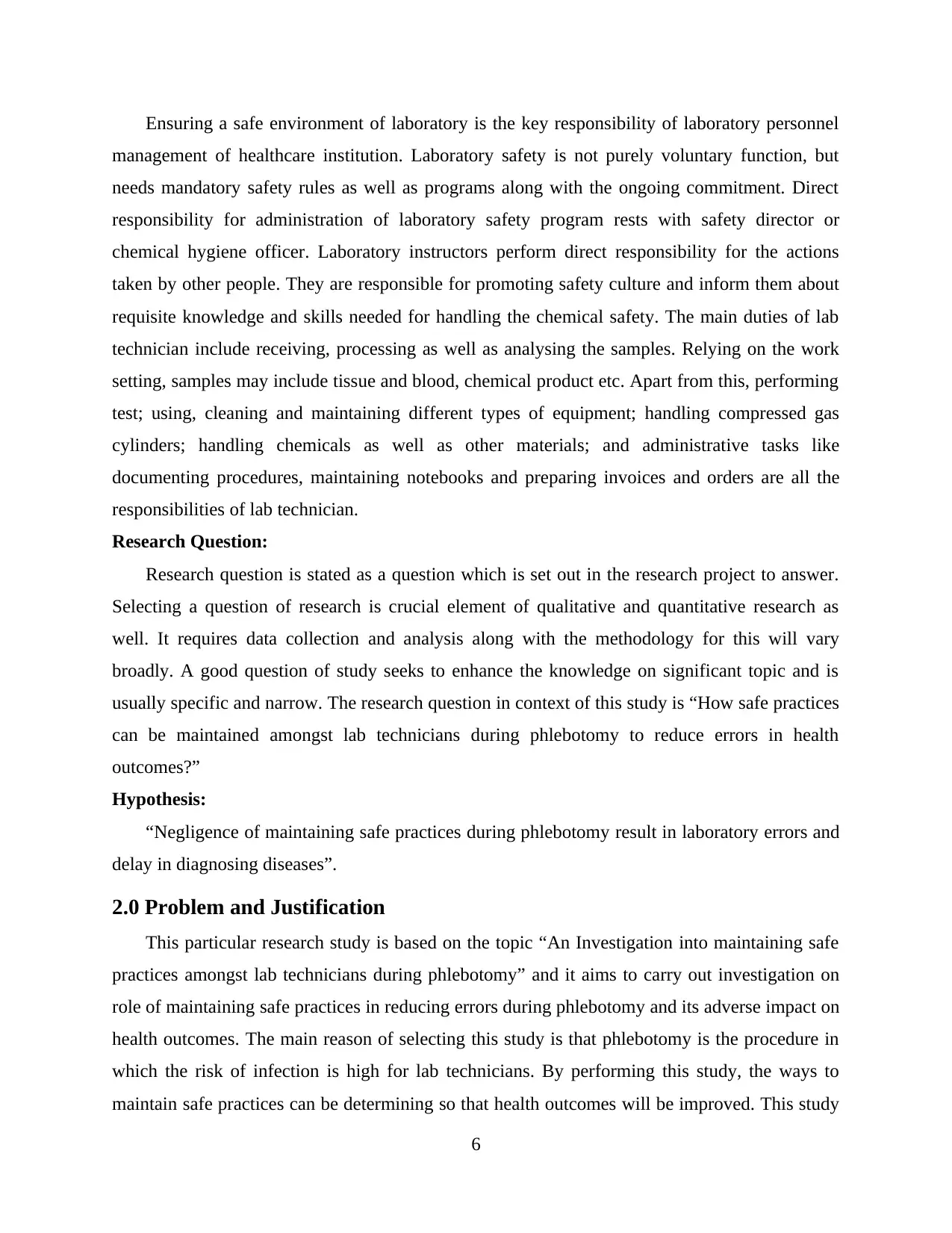
Ensuring a safe environment of laboratory is the key responsibility of laboratory personnel
management of healthcare institution. Laboratory safety is not purely voluntary function, but
needs mandatory safety rules as well as programs along with the ongoing commitment. Direct
responsibility for administration of laboratory safety program rests with safety director or
chemical hygiene officer. Laboratory instructors perform direct responsibility for the actions
taken by other people. They are responsible for promoting safety culture and inform them about
requisite knowledge and skills needed for handling the chemical safety. The main duties of lab
technician include receiving, processing as well as analysing the samples. Relying on the work
setting, samples may include tissue and blood, chemical product etc. Apart from this, performing
test; using, cleaning and maintaining different types of equipment; handling compressed gas
cylinders; handling chemicals as well as other materials; and administrative tasks like
documenting procedures, maintaining notebooks and preparing invoices and orders are all the
responsibilities of lab technician.
Research Question:
Research question is stated as a question which is set out in the research project to answer.
Selecting a question of research is crucial element of qualitative and quantitative research as
well. It requires data collection and analysis along with the methodology for this will vary
broadly. A good question of study seeks to enhance the knowledge on significant topic and is
usually specific and narrow. The research question in context of this study is “How safe practices
can be maintained amongst lab technicians during phlebotomy to reduce errors in health
outcomes?”
Hypothesis:
“Negligence of maintaining safe practices during phlebotomy result in laboratory errors and
delay in diagnosing diseases”.
2.0 Problem and Justification
This particular research study is based on the topic “An Investigation into maintaining safe
practices amongst lab technicians during phlebotomy” and it aims to carry out investigation on
role of maintaining safe practices in reducing errors during phlebotomy and its adverse impact on
health outcomes. The main reason of selecting this study is that phlebotomy is the procedure in
which the risk of infection is high for lab technicians. By performing this study, the ways to
maintain safe practices can be determining so that health outcomes will be improved. This study
6
management of healthcare institution. Laboratory safety is not purely voluntary function, but
needs mandatory safety rules as well as programs along with the ongoing commitment. Direct
responsibility for administration of laboratory safety program rests with safety director or
chemical hygiene officer. Laboratory instructors perform direct responsibility for the actions
taken by other people. They are responsible for promoting safety culture and inform them about
requisite knowledge and skills needed for handling the chemical safety. The main duties of lab
technician include receiving, processing as well as analysing the samples. Relying on the work
setting, samples may include tissue and blood, chemical product etc. Apart from this, performing
test; using, cleaning and maintaining different types of equipment; handling compressed gas
cylinders; handling chemicals as well as other materials; and administrative tasks like
documenting procedures, maintaining notebooks and preparing invoices and orders are all the
responsibilities of lab technician.
Research Question:
Research question is stated as a question which is set out in the research project to answer.
Selecting a question of research is crucial element of qualitative and quantitative research as
well. It requires data collection and analysis along with the methodology for this will vary
broadly. A good question of study seeks to enhance the knowledge on significant topic and is
usually specific and narrow. The research question in context of this study is “How safe practices
can be maintained amongst lab technicians during phlebotomy to reduce errors in health
outcomes?”
Hypothesis:
“Negligence of maintaining safe practices during phlebotomy result in laboratory errors and
delay in diagnosing diseases”.
2.0 Problem and Justification
This particular research study is based on the topic “An Investigation into maintaining safe
practices amongst lab technicians during phlebotomy” and it aims to carry out investigation on
role of maintaining safe practices in reducing errors during phlebotomy and its adverse impact on
health outcomes. The main reason of selecting this study is that phlebotomy is the procedure in
which the risk of infection is high for lab technicians. By performing this study, the ways to
maintain safe practices can be determining so that health outcomes will be improved. This study
6
⊘ This is a preview!⊘
Do you want full access?
Subscribe today to unlock all pages.

Trusted by 1+ million students worldwide
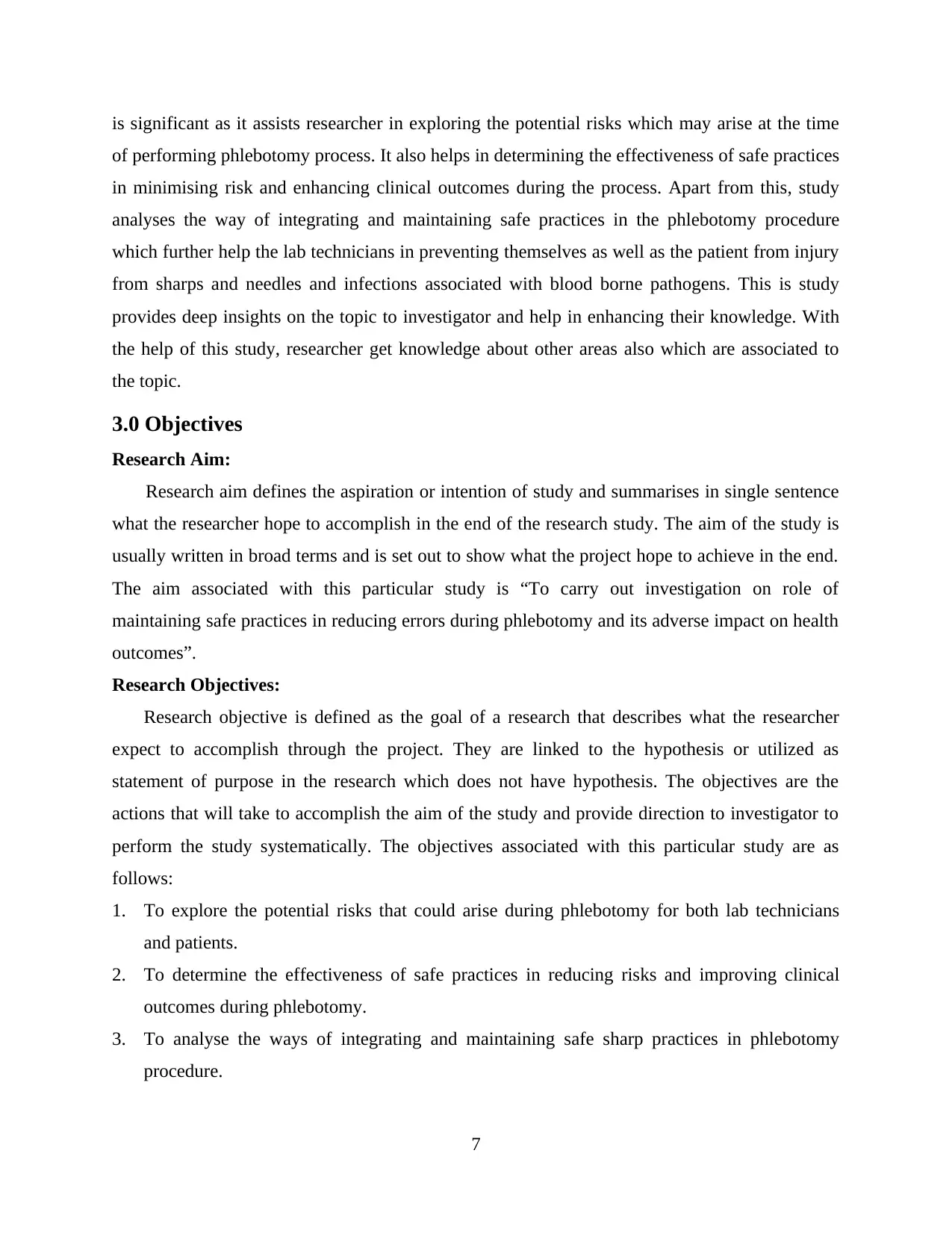
is significant as it assists researcher in exploring the potential risks which may arise at the time
of performing phlebotomy process. It also helps in determining the effectiveness of safe practices
in minimising risk and enhancing clinical outcomes during the process. Apart from this, study
analyses the way of integrating and maintaining safe practices in the phlebotomy procedure
which further help the lab technicians in preventing themselves as well as the patient from injury
from sharps and needles and infections associated with blood borne pathogens. This is study
provides deep insights on the topic to investigator and help in enhancing their knowledge. With
the help of this study, researcher get knowledge about other areas also which are associated to
the topic.
3.0 Objectives
Research Aim:
Research aim defines the aspiration or intention of study and summarises in single sentence
what the researcher hope to accomplish in the end of the research study. The aim of the study is
usually written in broad terms and is set out to show what the project hope to achieve in the end.
The aim associated with this particular study is “To carry out investigation on role of
maintaining safe practices in reducing errors during phlebotomy and its adverse impact on health
outcomes”.
Research Objectives:
Research objective is defined as the goal of a research that describes what the researcher
expect to accomplish through the project. They are linked to the hypothesis or utilized as
statement of purpose in the research which does not have hypothesis. The objectives are the
actions that will take to accomplish the aim of the study and provide direction to investigator to
perform the study systematically. The objectives associated with this particular study are as
follows:
1. To explore the potential risks that could arise during phlebotomy for both lab technicians
and patients.
2. To determine the effectiveness of safe practices in reducing risks and improving clinical
outcomes during phlebotomy.
3. To analyse the ways of integrating and maintaining safe sharp practices in phlebotomy
procedure.
7
of performing phlebotomy process. It also helps in determining the effectiveness of safe practices
in minimising risk and enhancing clinical outcomes during the process. Apart from this, study
analyses the way of integrating and maintaining safe practices in the phlebotomy procedure
which further help the lab technicians in preventing themselves as well as the patient from injury
from sharps and needles and infections associated with blood borne pathogens. This is study
provides deep insights on the topic to investigator and help in enhancing their knowledge. With
the help of this study, researcher get knowledge about other areas also which are associated to
the topic.
3.0 Objectives
Research Aim:
Research aim defines the aspiration or intention of study and summarises in single sentence
what the researcher hope to accomplish in the end of the research study. The aim of the study is
usually written in broad terms and is set out to show what the project hope to achieve in the end.
The aim associated with this particular study is “To carry out investigation on role of
maintaining safe practices in reducing errors during phlebotomy and its adverse impact on health
outcomes”.
Research Objectives:
Research objective is defined as the goal of a research that describes what the researcher
expect to accomplish through the project. They are linked to the hypothesis or utilized as
statement of purpose in the research which does not have hypothesis. The objectives are the
actions that will take to accomplish the aim of the study and provide direction to investigator to
perform the study systematically. The objectives associated with this particular study are as
follows:
1. To explore the potential risks that could arise during phlebotomy for both lab technicians
and patients.
2. To determine the effectiveness of safe practices in reducing risks and improving clinical
outcomes during phlebotomy.
3. To analyse the ways of integrating and maintaining safe sharp practices in phlebotomy
procedure.
7
Paraphrase This Document
Need a fresh take? Get an instant paraphrase of this document with our AI Paraphraser
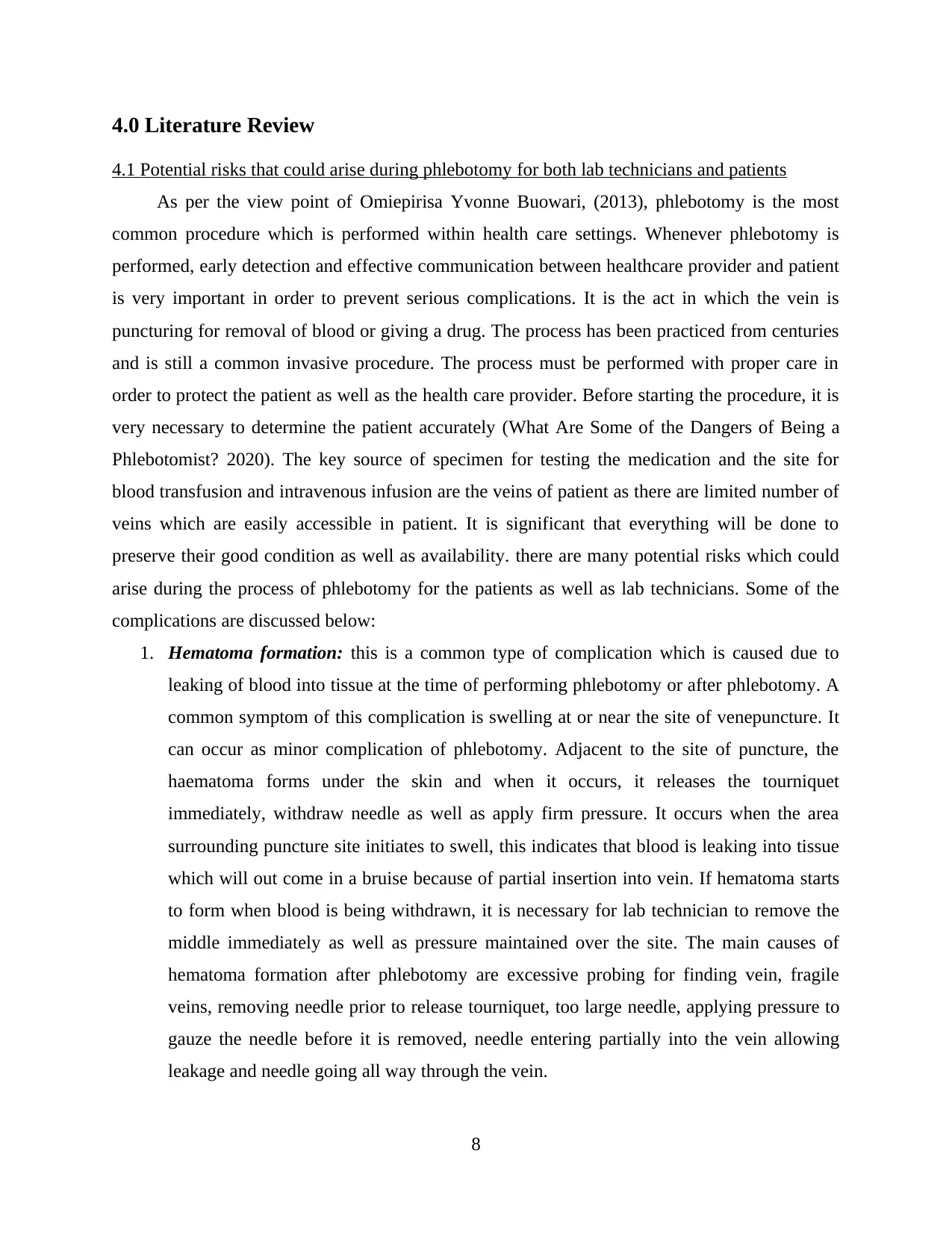
4.0 Literature Review
4.1 Potential risks that could arise during phlebotomy for both lab technicians and patients
As per the view point of Omiepirisa Yvonne Buowari, (2013), phlebotomy is the most
common procedure which is performed within health care settings. Whenever phlebotomy is
performed, early detection and effective communication between healthcare provider and patient
is very important in order to prevent serious complications. It is the act in which the vein is
puncturing for removal of blood or giving a drug. The process has been practiced from centuries
and is still a common invasive procedure. The process must be performed with proper care in
order to protect the patient as well as the health care provider. Before starting the procedure, it is
very necessary to determine the patient accurately (What Are Some of the Dangers of Being a
Phlebotomist? 2020). The key source of specimen for testing the medication and the site for
blood transfusion and intravenous infusion are the veins of patient as there are limited number of
veins which are easily accessible in patient. It is significant that everything will be done to
preserve their good condition as well as availability. there are many potential risks which could
arise during the process of phlebotomy for the patients as well as lab technicians. Some of the
complications are discussed below:
1. Hematoma formation: this is a common type of complication which is caused due to
leaking of blood into tissue at the time of performing phlebotomy or after phlebotomy. A
common symptom of this complication is swelling at or near the site of venepuncture. It
can occur as minor complication of phlebotomy. Adjacent to the site of puncture, the
haematoma forms under the skin and when it occurs, it releases the tourniquet
immediately, withdraw needle as well as apply firm pressure. It occurs when the area
surrounding puncture site initiates to swell, this indicates that blood is leaking into tissue
which will out come in a bruise because of partial insertion into vein. If hematoma starts
to form when blood is being withdrawn, it is necessary for lab technician to remove the
middle immediately as well as pressure maintained over the site. The main causes of
hematoma formation after phlebotomy are excessive probing for finding vein, fragile
veins, removing needle prior to release tourniquet, too large needle, applying pressure to
gauze the needle before it is removed, needle entering partially into the vein allowing
leakage and needle going all way through the vein.
8
4.1 Potential risks that could arise during phlebotomy for both lab technicians and patients
As per the view point of Omiepirisa Yvonne Buowari, (2013), phlebotomy is the most
common procedure which is performed within health care settings. Whenever phlebotomy is
performed, early detection and effective communication between healthcare provider and patient
is very important in order to prevent serious complications. It is the act in which the vein is
puncturing for removal of blood or giving a drug. The process has been practiced from centuries
and is still a common invasive procedure. The process must be performed with proper care in
order to protect the patient as well as the health care provider. Before starting the procedure, it is
very necessary to determine the patient accurately (What Are Some of the Dangers of Being a
Phlebotomist? 2020). The key source of specimen for testing the medication and the site for
blood transfusion and intravenous infusion are the veins of patient as there are limited number of
veins which are easily accessible in patient. It is significant that everything will be done to
preserve their good condition as well as availability. there are many potential risks which could
arise during the process of phlebotomy for the patients as well as lab technicians. Some of the
complications are discussed below:
1. Hematoma formation: this is a common type of complication which is caused due to
leaking of blood into tissue at the time of performing phlebotomy or after phlebotomy. A
common symptom of this complication is swelling at or near the site of venepuncture. It
can occur as minor complication of phlebotomy. Adjacent to the site of puncture, the
haematoma forms under the skin and when it occurs, it releases the tourniquet
immediately, withdraw needle as well as apply firm pressure. It occurs when the area
surrounding puncture site initiates to swell, this indicates that blood is leaking into tissue
which will out come in a bruise because of partial insertion into vein. If hematoma starts
to form when blood is being withdrawn, it is necessary for lab technician to remove the
middle immediately as well as pressure maintained over the site. The main causes of
hematoma formation after phlebotomy are excessive probing for finding vein, fragile
veins, removing needle prior to release tourniquet, too large needle, applying pressure to
gauze the needle before it is removed, needle entering partially into the vein allowing
leakage and needle going all way through the vein.
8
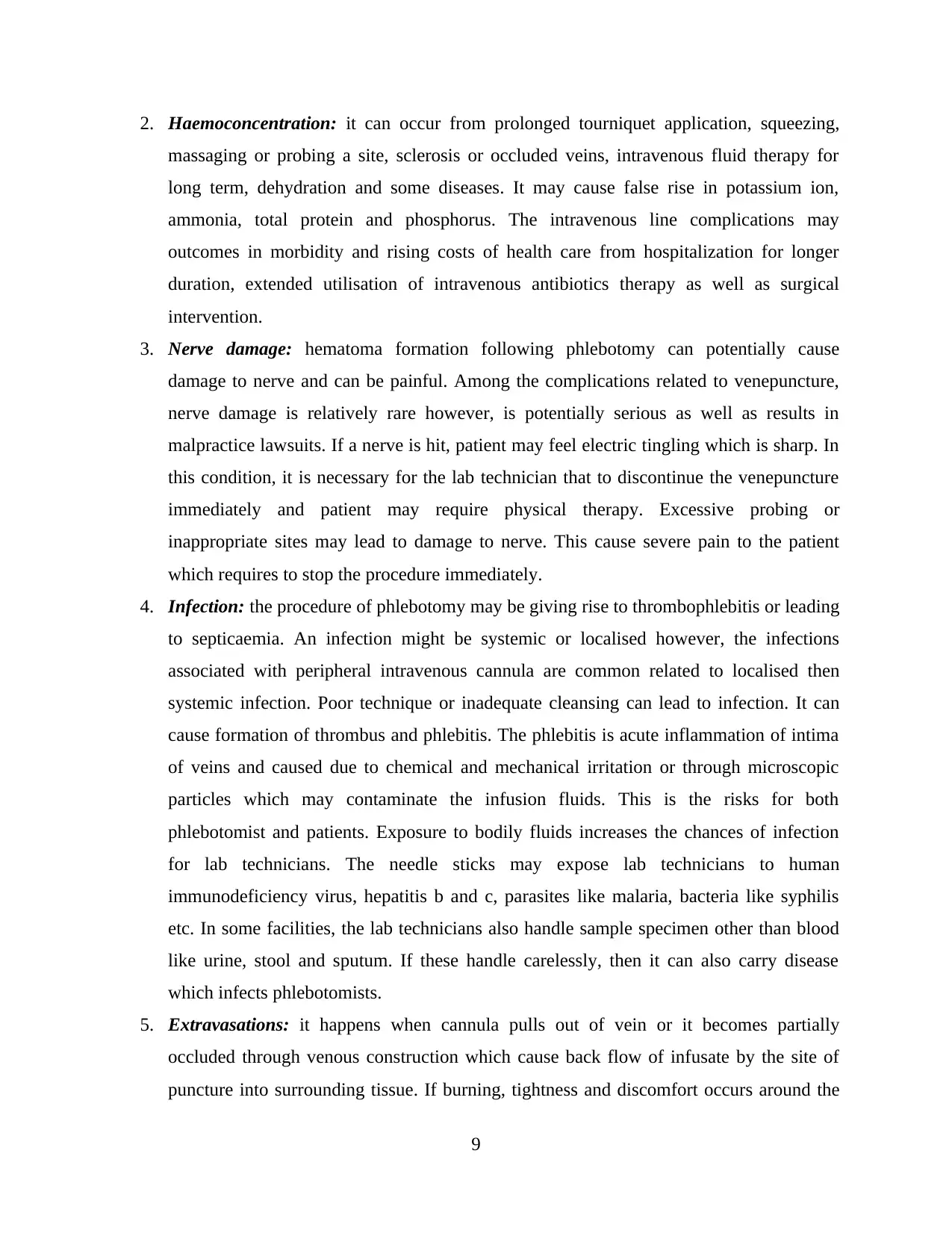
2. Haemoconcentration: it can occur from prolonged tourniquet application, squeezing,
massaging or probing a site, sclerosis or occluded veins, intravenous fluid therapy for
long term, dehydration and some diseases. It may cause false rise in potassium ion,
ammonia, total protein and phosphorus. The intravenous line complications may
outcomes in morbidity and rising costs of health care from hospitalization for longer
duration, extended utilisation of intravenous antibiotics therapy as well as surgical
intervention.
3. Nerve damage: hematoma formation following phlebotomy can potentially cause
damage to nerve and can be painful. Among the complications related to venepuncture,
nerve damage is relatively rare however, is potentially serious as well as results in
malpractice lawsuits. If a nerve is hit, patient may feel electric tingling which is sharp. In
this condition, it is necessary for the lab technician that to discontinue the venepuncture
immediately and patient may require physical therapy. Excessive probing or
inappropriate sites may lead to damage to nerve. This cause severe pain to the patient
which requires to stop the procedure immediately.
4. Infection: the procedure of phlebotomy may be giving rise to thrombophlebitis or leading
to septicaemia. An infection might be systemic or localised however, the infections
associated with peripheral intravenous cannula are common related to localised then
systemic infection. Poor technique or inadequate cleansing can lead to infection. It can
cause formation of thrombus and phlebitis. The phlebitis is acute inflammation of intima
of veins and caused due to chemical and mechanical irritation or through microscopic
particles which may contaminate the infusion fluids. This is the risks for both
phlebotomist and patients. Exposure to bodily fluids increases the chances of infection
for lab technicians. The needle sticks may expose lab technicians to human
immunodeficiency virus, hepatitis b and c, parasites like malaria, bacteria like syphilis
etc. In some facilities, the lab technicians also handle sample specimen other than blood
like urine, stool and sputum. If these handle carelessly, then it can also carry disease
which infects phlebotomists.
5. Extravasations: it happens when cannula pulls out of vein or it becomes partially
occluded through venous construction which cause back flow of infusate by the site of
puncture into surrounding tissue. If burning, tightness and discomfort occurs around the
9
massaging or probing a site, sclerosis or occluded veins, intravenous fluid therapy for
long term, dehydration and some diseases. It may cause false rise in potassium ion,
ammonia, total protein and phosphorus. The intravenous line complications may
outcomes in morbidity and rising costs of health care from hospitalization for longer
duration, extended utilisation of intravenous antibiotics therapy as well as surgical
intervention.
3. Nerve damage: hematoma formation following phlebotomy can potentially cause
damage to nerve and can be painful. Among the complications related to venepuncture,
nerve damage is relatively rare however, is potentially serious as well as results in
malpractice lawsuits. If a nerve is hit, patient may feel electric tingling which is sharp. In
this condition, it is necessary for the lab technician that to discontinue the venepuncture
immediately and patient may require physical therapy. Excessive probing or
inappropriate sites may lead to damage to nerve. This cause severe pain to the patient
which requires to stop the procedure immediately.
4. Infection: the procedure of phlebotomy may be giving rise to thrombophlebitis or leading
to septicaemia. An infection might be systemic or localised however, the infections
associated with peripheral intravenous cannula are common related to localised then
systemic infection. Poor technique or inadequate cleansing can lead to infection. It can
cause formation of thrombus and phlebitis. The phlebitis is acute inflammation of intima
of veins and caused due to chemical and mechanical irritation or through microscopic
particles which may contaminate the infusion fluids. This is the risks for both
phlebotomist and patients. Exposure to bodily fluids increases the chances of infection
for lab technicians. The needle sticks may expose lab technicians to human
immunodeficiency virus, hepatitis b and c, parasites like malaria, bacteria like syphilis
etc. In some facilities, the lab technicians also handle sample specimen other than blood
like urine, stool and sputum. If these handle carelessly, then it can also carry disease
which infects phlebotomists.
5. Extravasations: it happens when cannula pulls out of vein or it becomes partially
occluded through venous construction which cause back flow of infusate by the site of
puncture into surrounding tissue. If burning, tightness and discomfort occurs around the
9
⊘ This is a preview!⊘
Do you want full access?
Subscribe today to unlock all pages.

Trusted by 1+ million students worldwide
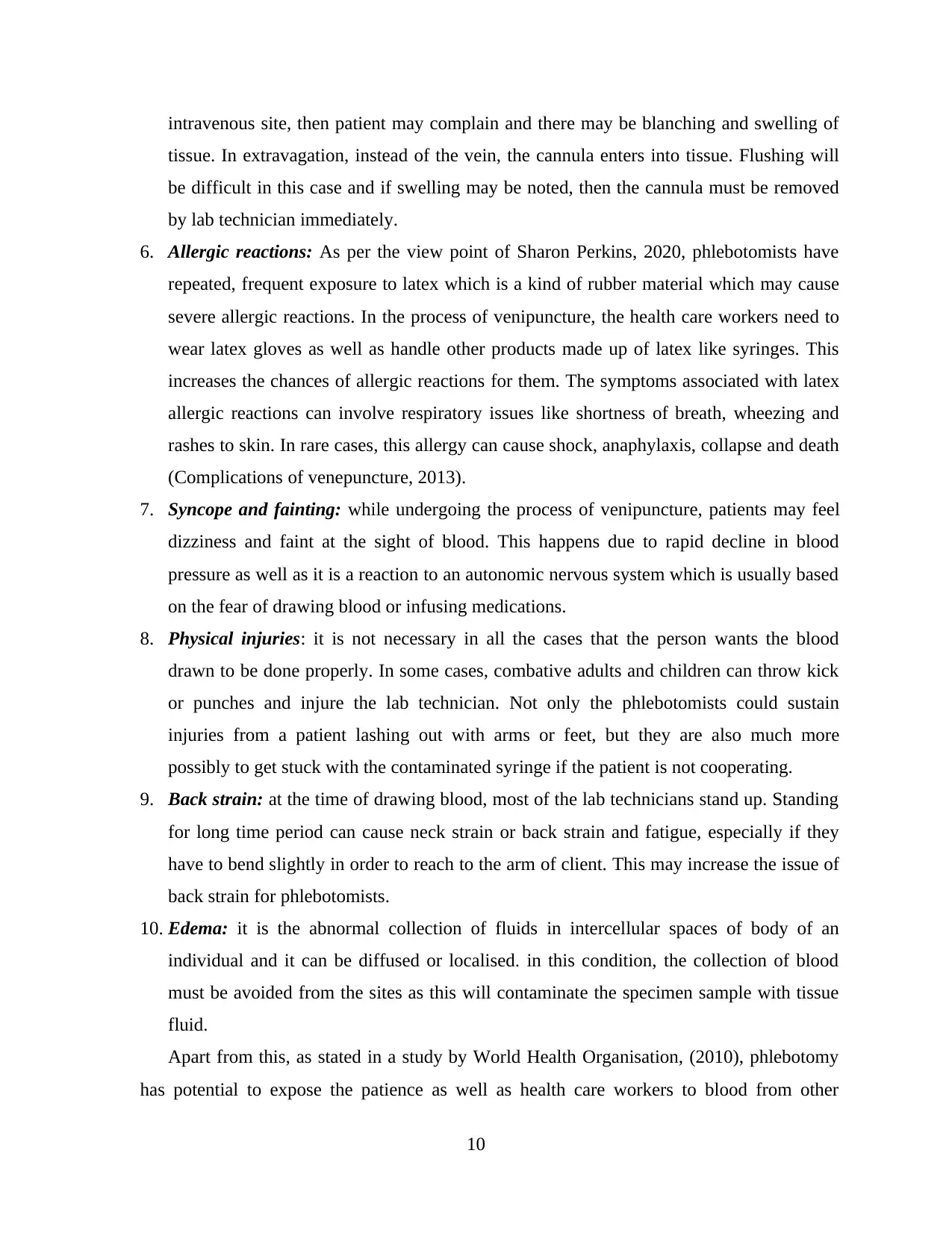
intravenous site, then patient may complain and there may be blanching and swelling of
tissue. In extravagation, instead of the vein, the cannula enters into tissue. Flushing will
be difficult in this case and if swelling may be noted, then the cannula must be removed
by lab technician immediately.
6. Allergic reactions: As per the view point of Sharon Perkins, 2020, phlebotomists have
repeated, frequent exposure to latex which is a kind of rubber material which may cause
severe allergic reactions. In the process of venipuncture, the health care workers need to
wear latex gloves as well as handle other products made up of latex like syringes. This
increases the chances of allergic reactions for them. The symptoms associated with latex
allergic reactions can involve respiratory issues like shortness of breath, wheezing and
rashes to skin. In rare cases, this allergy can cause shock, anaphylaxis, collapse and death
(Complications of venepuncture, 2013).
7. Syncope and fainting: while undergoing the process of venipuncture, patients may feel
dizziness and faint at the sight of blood. This happens due to rapid decline in blood
pressure as well as it is a reaction to an autonomic nervous system which is usually based
on the fear of drawing blood or infusing medications.
8. Physical injuries: it is not necessary in all the cases that the person wants the blood
drawn to be done properly. In some cases, combative adults and children can throw kick
or punches and injure the lab technician. Not only the phlebotomists could sustain
injuries from a patient lashing out with arms or feet, but they are also much more
possibly to get stuck with the contaminated syringe if the patient is not cooperating.
9. Back strain: at the time of drawing blood, most of the lab technicians stand up. Standing
for long time period can cause neck strain or back strain and fatigue, especially if they
have to bend slightly in order to reach to the arm of client. This may increase the issue of
back strain for phlebotomists.
10. Edema: it is the abnormal collection of fluids in intercellular spaces of body of an
individual and it can be diffused or localised. in this condition, the collection of blood
must be avoided from the sites as this will contaminate the specimen sample with tissue
fluid.
Apart from this, as stated in a study by World Health Organisation, (2010), phlebotomy
has potential to expose the patience as well as health care workers to blood from other
10
tissue. In extravagation, instead of the vein, the cannula enters into tissue. Flushing will
be difficult in this case and if swelling may be noted, then the cannula must be removed
by lab technician immediately.
6. Allergic reactions: As per the view point of Sharon Perkins, 2020, phlebotomists have
repeated, frequent exposure to latex which is a kind of rubber material which may cause
severe allergic reactions. In the process of venipuncture, the health care workers need to
wear latex gloves as well as handle other products made up of latex like syringes. This
increases the chances of allergic reactions for them. The symptoms associated with latex
allergic reactions can involve respiratory issues like shortness of breath, wheezing and
rashes to skin. In rare cases, this allergy can cause shock, anaphylaxis, collapse and death
(Complications of venepuncture, 2013).
7. Syncope and fainting: while undergoing the process of venipuncture, patients may feel
dizziness and faint at the sight of blood. This happens due to rapid decline in blood
pressure as well as it is a reaction to an autonomic nervous system which is usually based
on the fear of drawing blood or infusing medications.
8. Physical injuries: it is not necessary in all the cases that the person wants the blood
drawn to be done properly. In some cases, combative adults and children can throw kick
or punches and injure the lab technician. Not only the phlebotomists could sustain
injuries from a patient lashing out with arms or feet, but they are also much more
possibly to get stuck with the contaminated syringe if the patient is not cooperating.
9. Back strain: at the time of drawing blood, most of the lab technicians stand up. Standing
for long time period can cause neck strain or back strain and fatigue, especially if they
have to bend slightly in order to reach to the arm of client. This may increase the issue of
back strain for phlebotomists.
10. Edema: it is the abnormal collection of fluids in intercellular spaces of body of an
individual and it can be diffused or localised. in this condition, the collection of blood
must be avoided from the sites as this will contaminate the specimen sample with tissue
fluid.
Apart from this, as stated in a study by World Health Organisation, (2010), phlebotomy
has potential to expose the patience as well as health care workers to blood from other
10
Paraphrase This Document
Need a fresh take? Get an instant paraphrase of this document with our AI Paraphraser
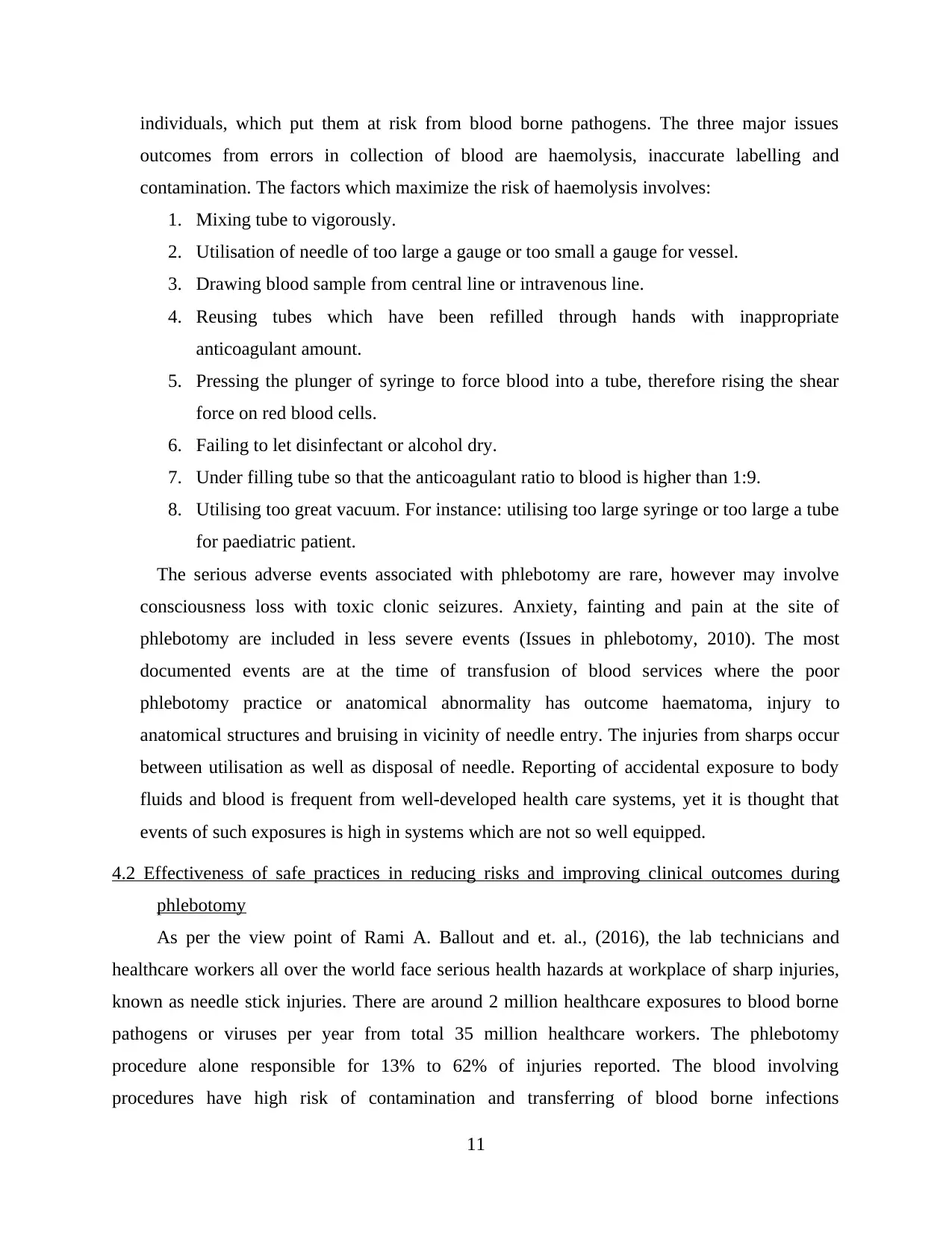
individuals, which put them at risk from blood borne pathogens. The three major issues
outcomes from errors in collection of blood are haemolysis, inaccurate labelling and
contamination. The factors which maximize the risk of haemolysis involves:
1. Mixing tube to vigorously.
2. Utilisation of needle of too large a gauge or too small a gauge for vessel.
3. Drawing blood sample from central line or intravenous line.
4. Reusing tubes which have been refilled through hands with inappropriate
anticoagulant amount.
5. Pressing the plunger of syringe to force blood into a tube, therefore rising the shear
force on red blood cells.
6. Failing to let disinfectant or alcohol dry.
7. Under filling tube so that the anticoagulant ratio to blood is higher than 1:9.
8. Utilising too great vacuum. For instance: utilising too large syringe or too large a tube
for paediatric patient.
The serious adverse events associated with phlebotomy are rare, however may involve
consciousness loss with toxic clonic seizures. Anxiety, fainting and pain at the site of
phlebotomy are included in less severe events (Issues in phlebotomy, 2010). The most
documented events are at the time of transfusion of blood services where the poor
phlebotomy practice or anatomical abnormality has outcome haematoma, injury to
anatomical structures and bruising in vicinity of needle entry. The injuries from sharps occur
between utilisation as well as disposal of needle. Reporting of accidental exposure to body
fluids and blood is frequent from well-developed health care systems, yet it is thought that
events of such exposures is high in systems which are not so well equipped.
4.2 Effectiveness of safe practices in reducing risks and improving clinical outcomes during
phlebotomy
As per the view point of Rami A. Ballout and et. al., (2016), the lab technicians and
healthcare workers all over the world face serious health hazards at workplace of sharp injuries,
known as needle stick injuries. There are around 2 million healthcare exposures to blood borne
pathogens or viruses per year from total 35 million healthcare workers. The phlebotomy
procedure alone responsible for 13% to 62% of injuries reported. The blood involving
procedures have high risk of contamination and transferring of blood borne infections
11
outcomes from errors in collection of blood are haemolysis, inaccurate labelling and
contamination. The factors which maximize the risk of haemolysis involves:
1. Mixing tube to vigorously.
2. Utilisation of needle of too large a gauge or too small a gauge for vessel.
3. Drawing blood sample from central line or intravenous line.
4. Reusing tubes which have been refilled through hands with inappropriate
anticoagulant amount.
5. Pressing the plunger of syringe to force blood into a tube, therefore rising the shear
force on red blood cells.
6. Failing to let disinfectant or alcohol dry.
7. Under filling tube so that the anticoagulant ratio to blood is higher than 1:9.
8. Utilising too great vacuum. For instance: utilising too large syringe or too large a tube
for paediatric patient.
The serious adverse events associated with phlebotomy are rare, however may involve
consciousness loss with toxic clonic seizures. Anxiety, fainting and pain at the site of
phlebotomy are included in less severe events (Issues in phlebotomy, 2010). The most
documented events are at the time of transfusion of blood services where the poor
phlebotomy practice or anatomical abnormality has outcome haematoma, injury to
anatomical structures and bruising in vicinity of needle entry. The injuries from sharps occur
between utilisation as well as disposal of needle. Reporting of accidental exposure to body
fluids and blood is frequent from well-developed health care systems, yet it is thought that
events of such exposures is high in systems which are not so well equipped.
4.2 Effectiveness of safe practices in reducing risks and improving clinical outcomes during
phlebotomy
As per the view point of Rami A. Ballout and et. al., (2016), the lab technicians and
healthcare workers all over the world face serious health hazards at workplace of sharp injuries,
known as needle stick injuries. There are around 2 million healthcare exposures to blood borne
pathogens or viruses per year from total 35 million healthcare workers. The phlebotomy
procedure alone responsible for 13% to 62% of injuries reported. The blood involving
procedures have high risk of contamination and transferring of blood borne infections
11
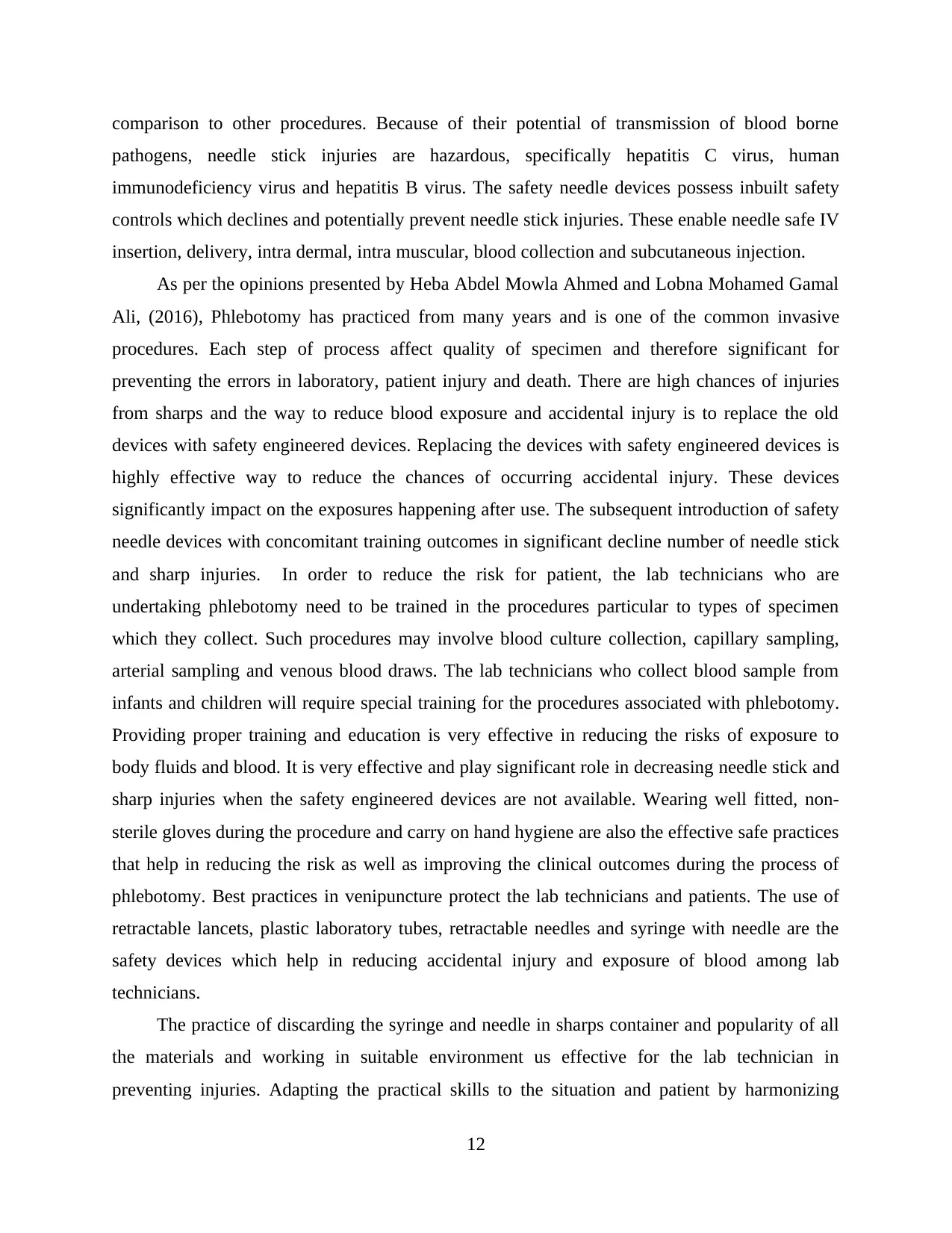
comparison to other procedures. Because of their potential of transmission of blood borne
pathogens, needle stick injuries are hazardous, specifically hepatitis C virus, human
immunodeficiency virus and hepatitis B virus. The safety needle devices possess inbuilt safety
controls which declines and potentially prevent needle stick injuries. These enable needle safe IV
insertion, delivery, intra dermal, intra muscular, blood collection and subcutaneous injection.
As per the opinions presented by Heba Abdel Mowla Ahmed and Lobna Mohamed Gamal
Ali, (2016), Phlebotomy has practiced from many years and is one of the common invasive
procedures. Each step of process affect quality of specimen and therefore significant for
preventing the errors in laboratory, patient injury and death. There are high chances of injuries
from sharps and the way to reduce blood exposure and accidental injury is to replace the old
devices with safety engineered devices. Replacing the devices with safety engineered devices is
highly effective way to reduce the chances of occurring accidental injury. These devices
significantly impact on the exposures happening after use. The subsequent introduction of safety
needle devices with concomitant training outcomes in significant decline number of needle stick
and sharp injuries. In order to reduce the risk for patient, the lab technicians who are
undertaking phlebotomy need to be trained in the procedures particular to types of specimen
which they collect. Such procedures may involve blood culture collection, capillary sampling,
arterial sampling and venous blood draws. The lab technicians who collect blood sample from
infants and children will require special training for the procedures associated with phlebotomy.
Providing proper training and education is very effective in reducing the risks of exposure to
body fluids and blood. It is very effective and play significant role in decreasing needle stick and
sharp injuries when the safety engineered devices are not available. Wearing well fitted, non-
sterile gloves during the procedure and carry on hand hygiene are also the effective safe practices
that help in reducing the risk as well as improving the clinical outcomes during the process of
phlebotomy. Best practices in venipuncture protect the lab technicians and patients. The use of
retractable lancets, plastic laboratory tubes, retractable needles and syringe with needle are the
safety devices which help in reducing accidental injury and exposure of blood among lab
technicians.
The practice of discarding the syringe and needle in sharps container and popularity of all
the materials and working in suitable environment us effective for the lab technician in
preventing injuries. Adapting the practical skills to the situation and patient by harmonizing
12
pathogens, needle stick injuries are hazardous, specifically hepatitis C virus, human
immunodeficiency virus and hepatitis B virus. The safety needle devices possess inbuilt safety
controls which declines and potentially prevent needle stick injuries. These enable needle safe IV
insertion, delivery, intra dermal, intra muscular, blood collection and subcutaneous injection.
As per the opinions presented by Heba Abdel Mowla Ahmed and Lobna Mohamed Gamal
Ali, (2016), Phlebotomy has practiced from many years and is one of the common invasive
procedures. Each step of process affect quality of specimen and therefore significant for
preventing the errors in laboratory, patient injury and death. There are high chances of injuries
from sharps and the way to reduce blood exposure and accidental injury is to replace the old
devices with safety engineered devices. Replacing the devices with safety engineered devices is
highly effective way to reduce the chances of occurring accidental injury. These devices
significantly impact on the exposures happening after use. The subsequent introduction of safety
needle devices with concomitant training outcomes in significant decline number of needle stick
and sharp injuries. In order to reduce the risk for patient, the lab technicians who are
undertaking phlebotomy need to be trained in the procedures particular to types of specimen
which they collect. Such procedures may involve blood culture collection, capillary sampling,
arterial sampling and venous blood draws. The lab technicians who collect blood sample from
infants and children will require special training for the procedures associated with phlebotomy.
Providing proper training and education is very effective in reducing the risks of exposure to
body fluids and blood. It is very effective and play significant role in decreasing needle stick and
sharp injuries when the safety engineered devices are not available. Wearing well fitted, non-
sterile gloves during the procedure and carry on hand hygiene are also the effective safe practices
that help in reducing the risk as well as improving the clinical outcomes during the process of
phlebotomy. Best practices in venipuncture protect the lab technicians and patients. The use of
retractable lancets, plastic laboratory tubes, retractable needles and syringe with needle are the
safety devices which help in reducing accidental injury and exposure of blood among lab
technicians.
The practice of discarding the syringe and needle in sharps container and popularity of all
the materials and working in suitable environment us effective for the lab technician in
preventing injuries. Adapting the practical skills to the situation and patient by harmonizing
12
⊘ This is a preview!⊘
Do you want full access?
Subscribe today to unlock all pages.

Trusted by 1+ million students worldwide
1 out of 35
Your All-in-One AI-Powered Toolkit for Academic Success.
+13062052269
info@desklib.com
Available 24*7 on WhatsApp / Email
![[object Object]](/_next/static/media/star-bottom.7253800d.svg)
Unlock your academic potential
Copyright © 2020–2025 A2Z Services. All Rights Reserved. Developed and managed by ZUCOL.


